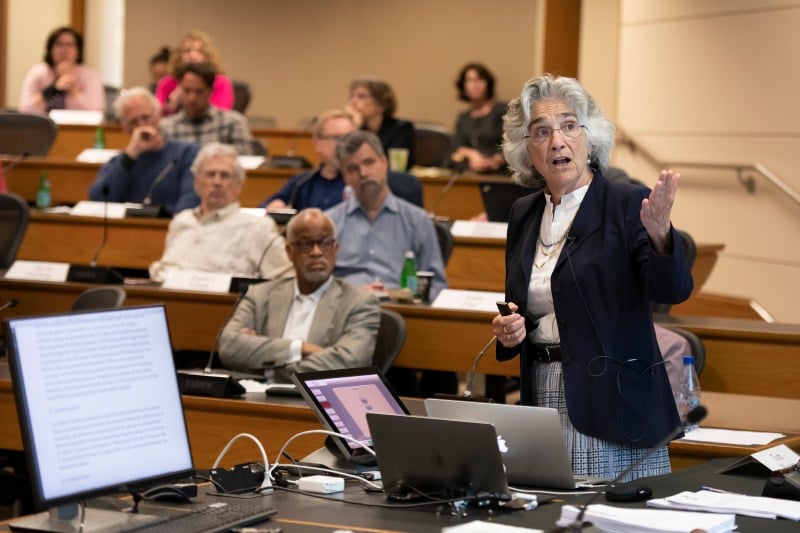Provost Persis Drell presented on the 2019-20 University budget plan at Thursday afternoon Faculty Senate meeting. She described the financial calculus behind the 2.1 percent growth in payout for the endowment for the upcoming fiscal year, which is lower than typical, and described Stanford’s financial priorities as reflected by the allocation of general funds.
“Stanford’s resources are significant but so are our aspirations,” Drell said.
As a result of the lower than anticipated endowment payout, the budget group and Drell have made some tough and contentious decisions about the use of general funds such as rejecting the request by Stanford Press for one time funds.
“The key priorities for allocation this year were financial aid, mental health support for our students and infrastructure for the future,” Drell said.
Endowment
Endowments in general are not intended only for the immediacy, Drell explained, but rather to indefinitely support a program or institution with its returns. Thus, in order to ensure intergenerational stability as costs rise, a certain amount of the endowment payout is reinvested back into the endowment corpus each year.
“We expect, long term, an average return of about 9 percent,” Drell said. “Over 50 years we have done a lot better than that. Over the last four years we have not done that well.”
Even when the endowment makes a 9 percent return, only 5.5 percent is paid out to the specific programs supported by the endowment, according to Drell. The remaining 3.5 percent is folded back into the endowment in anticipation of future rising costs.
The budget group decides the endowment payout each year by considering the performance of the endowment in past years as well as the current year in order to dampen year-to-year variation in the stock market.
“There is a lot of fluidity in the market,” Drell said. “We use a smoothing formula, and the point of that formula is to dampen all those gyrations that the market can do.”
However, a smoothing formula can not do much after multiple years of lower-than-expected endowment returns, Drell added.
For the last four years endowment shares have appreciated 7 percent per year, or 2 percent below the budget group’s expectation. As a result, the growth in the endowment payout is just 2.1 percent, which is not expected to cover anticipated cost increases for scholarships, professorships, and programs funded by the endowment.
General Fund
General funds come from a variety of sources and can be spent at the discretion of the budget group. The single largest source flowing into the general fund is student tuition and fees, which account for nearly of half of the 70 million of base general funds.
Drell noted that the budget group is very conscious about their use of general funds because they come, in a big part, directly from tuition.
For the upcoming fiscal year, the budget group allocated the general funds primarily to faculty salaries and benefits, undergraduate financial aid and mental health resources. Undergraduate financial aid grew 7.2 percent in the last year, and the general funds covered the additional expense.
“The general funds component of the Undergraduate Financial Aid was 24 percent of this year’s budget,” Drell said. “I fundamentally think this is a good news story for Stanford, but it was a big hit.”
Ways of Thinking/Ways of Doing
After the budget presentation, Chair of the Breadth Governance Board Aron Rodrigue and the Chair of Undergraduate Standards and policies Bruce Clemens presented on data they had collected on Stanford’s general education requirements, also known as the Ways of Thinking/Ways of Doing requirements (WAYS).
Rodrigue and Clemens identify a couple of problems with the requirements and from an initial list of WAYS “myths” that they looked into. Two of the “myths” they analyzed were true.
“There are more WAYS courses in Humanities and Arts,” said Clemens, “and it’s mostly true that students take the minimum WAYS outside of their major.”
In addition, Clemens pointed out that in a University exit survey, 30 percent of humanities majors self-reported that they had not developed their ability to engage in scientific inquiry while at Stanford.
“What’s the evidence that students are getting a deeper, more coherent education and that they are not utilitarian about their general education requirements?” asked philosophy professor Kenneth Taylor. “WAYS was supposed to solve that.”
Taylor argued that WAYS were not an improvement on the previous breadth requirements they replaced.
“I think that statistics show that we haven’t accomplished anything with WAYS. That is how I would put it,” he added.
There were a variety of suggestions from the faculty on how to improve the state of WAYS, ranging from better faculty training to classes designed specifically to meet WAYS requirements.
“I am of the opinion that we should do away with general education requirements altogether and put our energy into admitting a diverse class,” comparative literature professor David Palumbo-Liu said. “Students would be more creative if they were unconstrained.”
This article has been correct to reflect that the 2.1 percent figure refers to the growth in the payout of the endowment, not the payout itself.
Contact Paxton Scott at paxtonsc ‘at’ stanford.edu.
